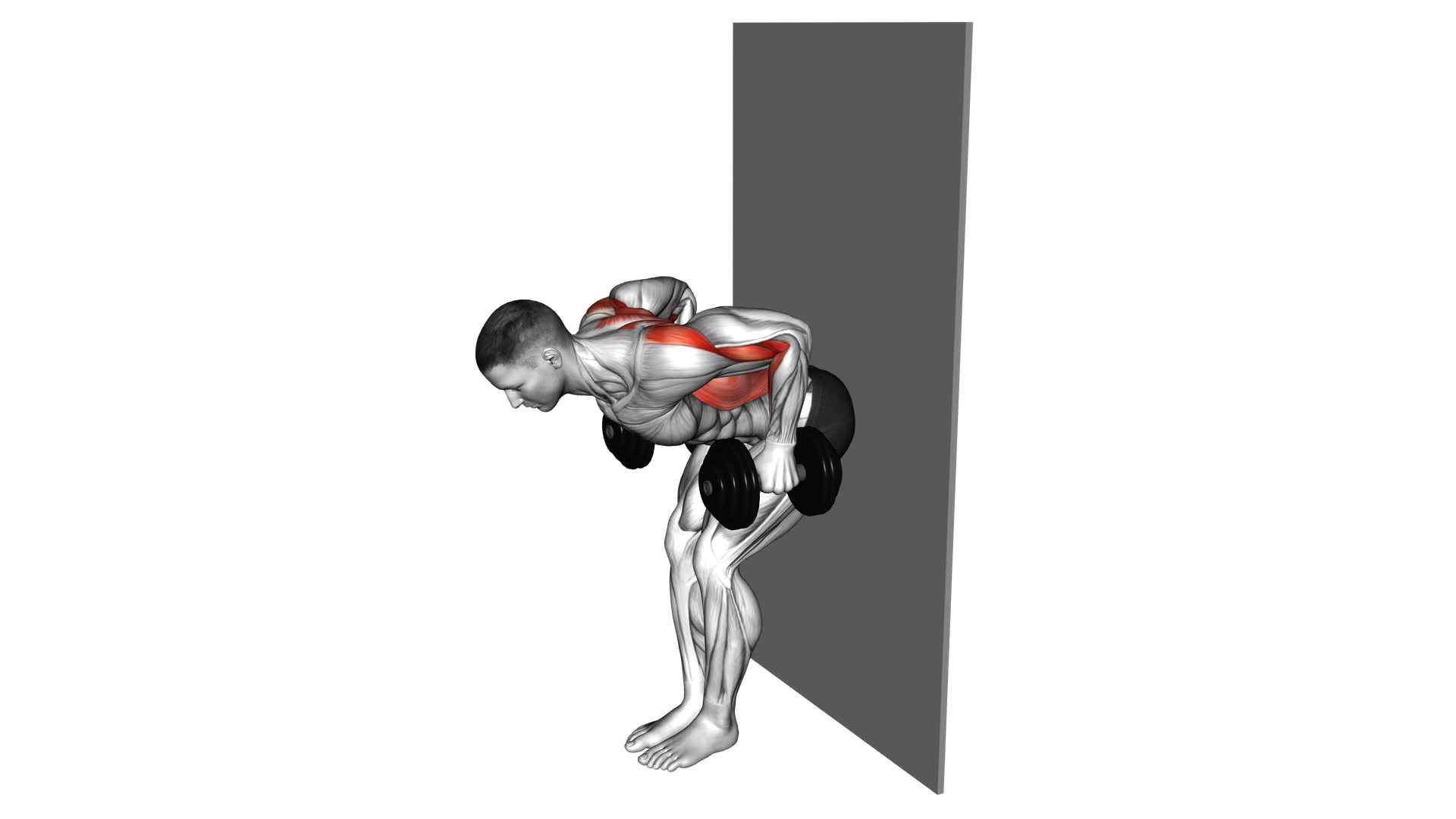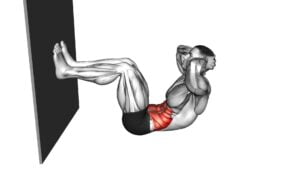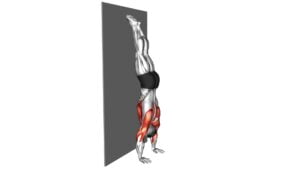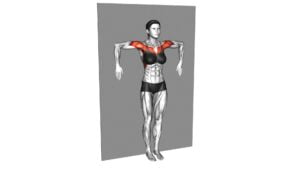Dumbbell Bent Over Row Against Wall – Video Exercise Guide & Tips

Looking to strengthen your back muscles? The Dumbbell Bent Over Row against the wall is a powerful exercise that targets your lats, traps, and rhomboids.
Watch This Exercise Video
In this video exercise guide, you'll learn the proper form and technique to maximize results. Discover variations for increased difficulty and common mistakes to avoid.
Follow the tips provided to ensure you're getting the most out of this exercise.
Let's get started on your journey to a stronger back!
Key Takeaways
- Targets lats, traps, and rhomboids
- Improves back strength and muscle definition
- Enhances muscle activation in the back
- Contributes to improved posture
Benefits of the Dumbbell Bent Over Row
You can experience significant improvements in your back strength and muscle definition by incorporating the dumbbell bent over row into your workout routine. This exercise is highly effective for muscle activation in your back, specifically targeting the latissimus dorsi, rhomboids, and trapezius muscles. By performing the dumbbell bent over row, you engage these muscles, helping to build strength and size.
In addition to muscle activation, this exercise also contributes to improved posture. As you row the dumbbells towards your chest, you engage the muscles in your upper back, which play a crucial role in maintaining proper posture. Strengthening these muscles can help counteract the negative effects of sitting for long periods and hunching over electronic devices.
To ensure you're maximizing the benefits of the dumbbell bent over row, it's important to maintain proper form and technique. This won't only prevent injury but also ensure that you're effectively targeting the intended muscles. So, let's move on to the next section where we'll discuss the proper form and technique for performing the dumbbell bent over row.
Proper Form and Technique
To ensure maximum benefits from the dumbbell bent over row, it's crucial to maintain proper form and technique. This not only prevents injury but also effectively targets the intended muscles.
Many people have common misconceptions about this exercise, so it's important to understand the correct way to perform it.
First and foremost, proper warm-up is essential. This helps to prepare your muscles for the exercise and reduces the risk of injury. Start with some light cardiovascular activity, such as jogging or jumping jacks, to increase blood flow and warm up your body.
Next, focus on stretching the muscles you'll be targeting during the dumbbell bent over row, such as your back, shoulders, and arms.
Once you're properly warmed up, it's time to focus on your form. Stand with your feet shoulder-width apart, knees slightly bent, and back straight. Holding a dumbbell in each hand, hinge forward at the hips while keeping your back flat. Pull the dumbbells up towards your chest, squeezing your shoulder blades together. Lower the dumbbells back down in a controlled manner.
Remember to keep your core engaged throughout the exercise and avoid rounding your back.
Variations for Increased Difficulty
Increase the difficulty of the dumbbell bent over row with these variations.
There are several progression options you can incorporate into your workout routine to challenge your muscles even more and increase muscle activation.
One option is to increase the weight of the dumbbells. As you become stronger, gradually increase the weight to provide more resistance for your muscles. This will help to further develop your back and arm muscles.
Another variation is to perform the exercise on an unstable surface, such as a balance board or a stability ball. This will engage your core muscles even more as they work to stabilize your body during the exercise.
You can also try performing the dumbbell bent over row with a single arm instead of both arms. This will require more stability and balance, as well as increase the intensity of the exercise.
Lastly, you can incorporate a pause at the top of the movement. This will increase the time under tension for your muscles, leading to greater muscle activation and growth.
Remember to always maintain proper form and technique throughout these variations to avoid injury. Start with lighter weights and gradually increase as you become comfortable with the increased difficulty.
Common Mistakes to Avoid
To ensure proper form and maximize the effectiveness of the dumbbell bent over row against the wall, it's important to avoid common mistakes.
Here are four common mistakes to avoid when performing this exercise:
- Rounding your back: One of the most common mistakes is rounding your back during the movement. This not only reduces the effectiveness of the exercise but also puts unnecessary strain on your spine. To maintain proper form, keep your back straight and engage your core throughout the entire exercise.
- Using too much weight: Another mistake is using weights that are too heavy for you to handle. This can lead to poor form and increase the risk of injury. Start with lighter weights and gradually increase the weight as you become stronger and more comfortable with the exercise.
- Jerking the weights: Avoid using momentum to lift the weights. Instead, focus on controlled movements and a slow and controlled descent. This will engage your muscles more effectively and prevent any sudden jerking movements that can strain your muscles or joints.
- Not fully extending your arms: Make sure to fully extend your arms at the bottom of the movement. This will ensure that you're getting the full range of motion and engaging your back muscles fully.
Tips for Maximizing Your Results
To get the most out of your dumbbell bent over row against the wall, follow these tips to maximize your results. Incorporating effective workout strategies and nutrition tips for muscle growth will help you achieve your fitness goals faster.
Firstly, when performing the dumbbell bent over row, focus on maintaining proper form. Keep your back straight and core engaged throughout the exercise. This will ensure that you're targeting the correct muscles and avoiding unnecessary strain on your back.
Secondly, vary your grip. By using different hand placements, such as an overhand grip or an underhand grip, you can target different muscles in your back. This will help to develop a well-rounded and balanced physique.
Additionally, consider increasing the weight gradually over time. As you become stronger, challenge yourself by using heavier dumbbells. This progressive overload will stimulate muscle growth and improve overall strength.
In terms of nutrition, make sure to consume enough protein to support muscle recovery and growth. Aim for a balanced diet that includes lean sources of protein, such as chicken, fish, tofu, and legumes. Additionally, fuel your workouts with carbohydrates to provide energy for optimal performance.
Frequently Asked Questions
Can the Dumbbell Bent Over Row Help Improve Posture?
The dumbbell bent over row is a great exercise for improving posture. By targeting the muscles in your upper back and shoulders, it helps to strengthen and stabilize those areas. Proper form and technique are crucial for maximizing the effectiveness of this exercise. By maintaining a neutral spine and engaging your core, you ensure that the targeted muscles are being properly activated.
What Muscles Does the Dumbbell Bent Over Row Primarily Target?
The dumbbell bent over row primarily targets your back muscles, specifically the latissimus dorsi, rhomboids, and trapezius. This exercise is great for building a strong and well-defined back.
For advanced lifters, there are variations of the dumbbell bent over row that can be incorporated to challenge your muscles even more.
However, it's important to avoid common mistakes such as using momentum to lift the weight or rounding your back.
Focus on maintaining proper form for maximum effectiveness and to prevent injury.
Is It Necessary to Use a Wall for Support While Performing the Dumbbell Bent Over Row?
Using a wall for support during the dumbbell bent over row isn't necessary, but it can be beneficial. It helps maintain proper form and stability, reducing the risk of injury.
However, there are alternative variations of the exercise that don't require a wall. These variations challenge your core and balance more, making the exercise more effective for overall strength and stability.
Ultimately, whether or not to use a wall depends on your individual fitness level and goals.
Can the Dumbbell Bent Over Row Be Modified for Individuals With Lower Back Issues?
If you're dealing with lower back issues, modifying the dumbbell bent over row can help you find a more comfortable exercise. Instead of bending over, try seated rows or cable rows.
These exercises allow you to maintain a supported position and focus on strengthening your back muscles without putting excess strain on your lower back.
How Often Should the Dumbbell Bent Over Row Be Incorporated Into a Workout Routine for Optimal Results?
For optimal results, incorporate the dumbbell bent over row into your workout routine regularly. The frequency depends on your fitness goals and overall program. Aim for 2-3 sessions per week to target your back muscles effectively.
To keep things interesting and challenge your muscles, try variations like single-arm rows or using different grip positions. Remember to maintain proper form and start with lighter weights before progressing.
Consult a fitness professional for personalized advice.
Conclusion
In conclusion, the dumbbell bent over row is a highly effective exercise for targeting the back muscles. By maintaining proper form and technique, you can maximize the benefits and avoid common mistakes.
Additionally, incorporating variations for increased difficulty will challenge your muscles even more. Remember to follow the provided tips to optimize your results and enhance your overall workout routine.

Author
Years ago, the spark of my life’s passion ignited in my mind the moment I stepped into the local gym for the first time. The inaugural bead of perspiration, the initial endeavor, the very first surge of endorphins, and a sense of pride that washed over me post-workout marked the beginning of my deep-seated interest in strength sports, fitness, and sports nutrition. This very curiosity blossomed rapidly into a profound fascination, propelling me to earn a Master’s degree in Physical Education from the Academy of Physical Education in Krakow, followed by a Sports Manager diploma from the Jagiellonian University. My journey of growth led me to gain more specialized qualifications, such as being a certified personal trainer with a focus on sports dietetics, a lifeguard, and an instructor for wellness and corrective gymnastics. Theoretical knowledge paired seamlessly with practical experience, reinforcing my belief that the transformation of individuals under my guidance was also a reflection of my personal growth. This belief holds true even today. Each day, I strive to push the boundaries and explore new realms. These realms gently elevate me to greater heights. The unique combination of passion for my field and the continuous quest for growth fuels my drive to break new ground.







